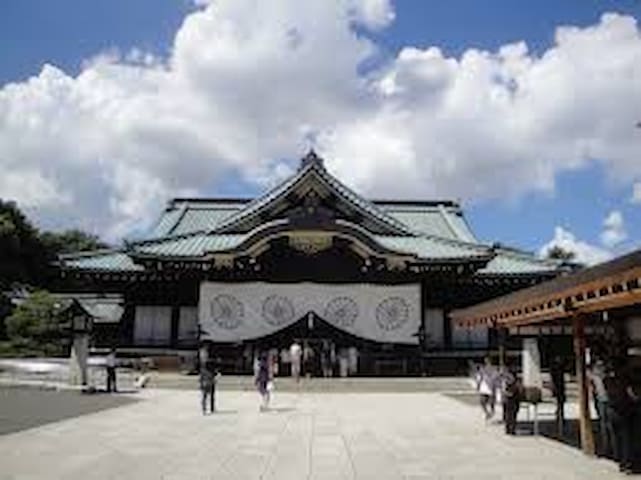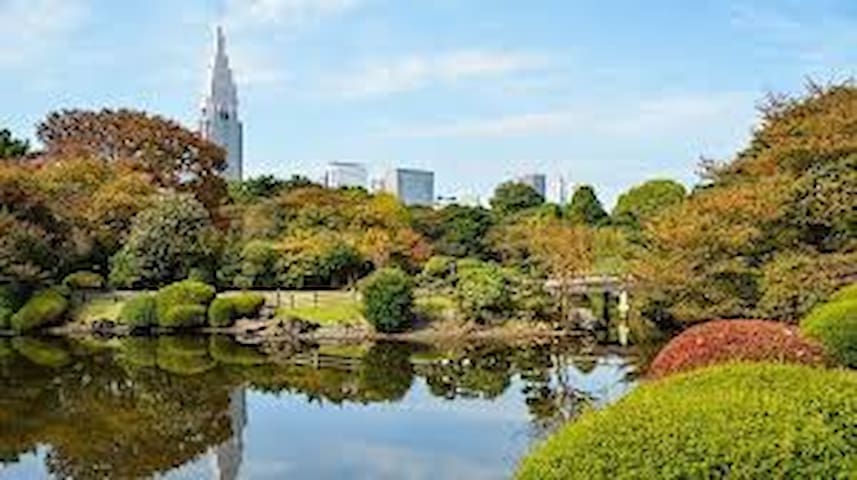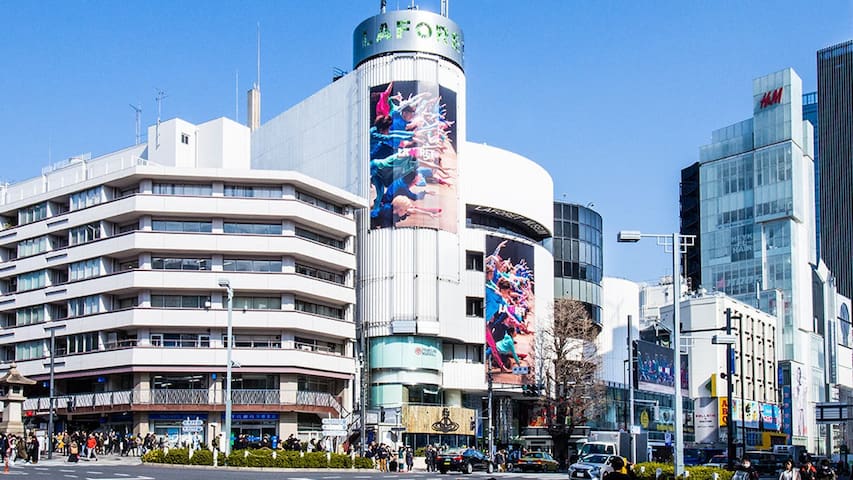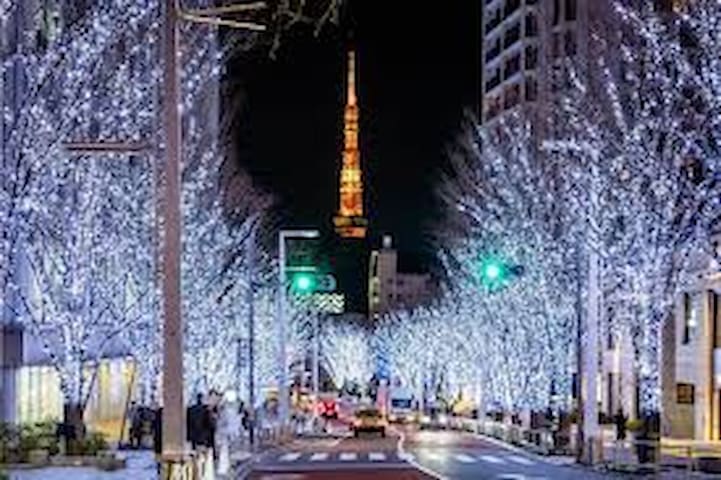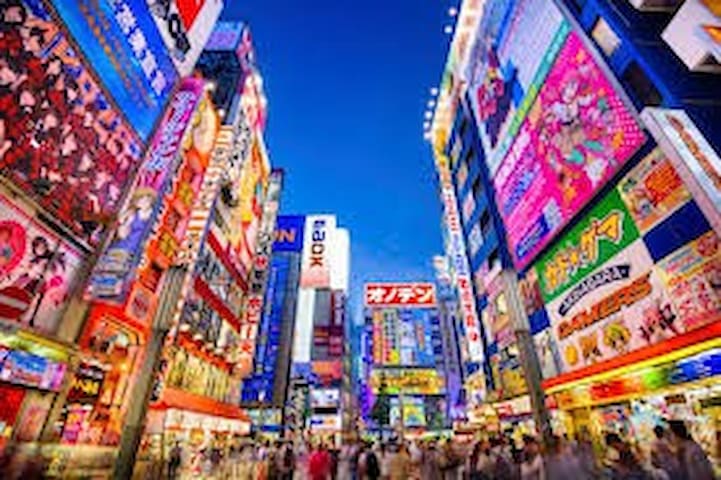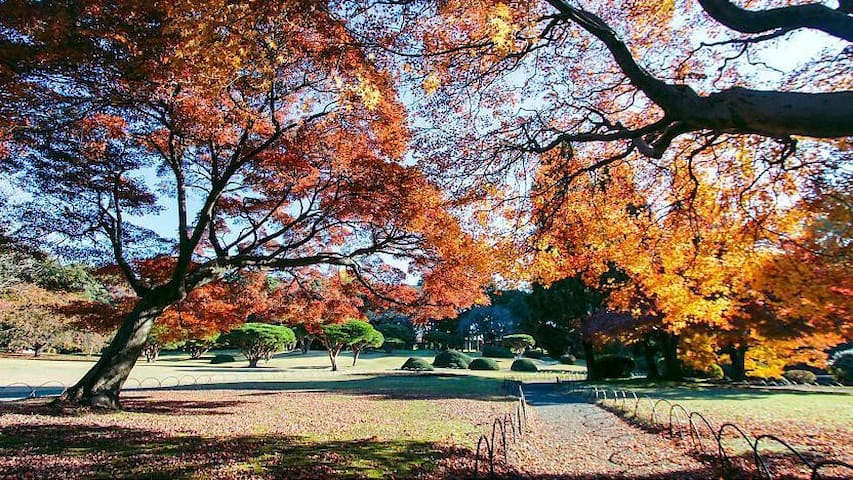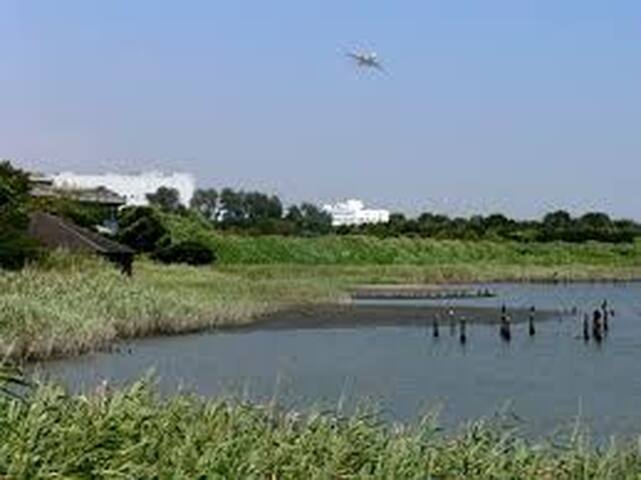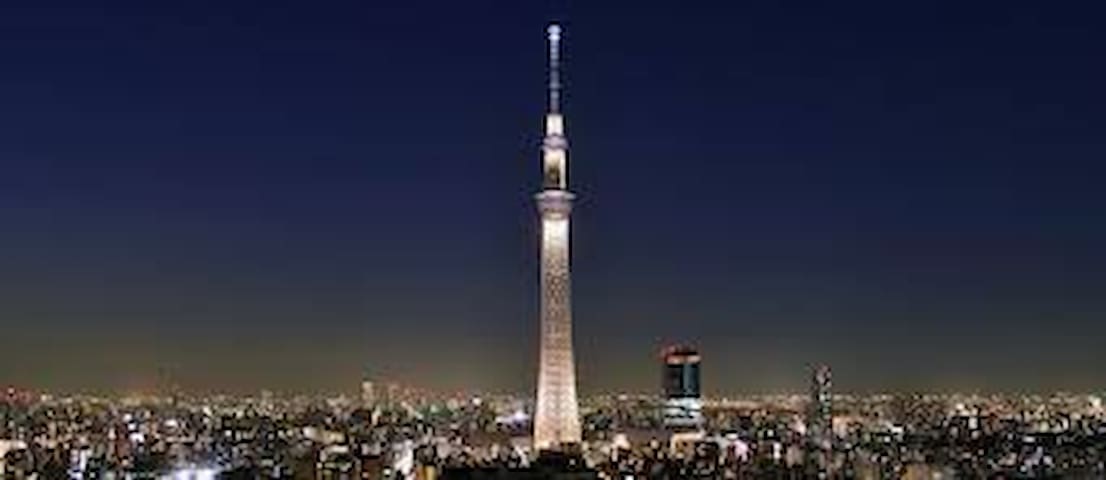Histric places
Meiji Shrine (明治神宮 Meiji Jingū), located in Shibuya, Tokyo, is the Shinto shrine that is dedicated to the deified spirits of Emperor Meiji and his wife, Empress Shōken. The shrine does not contain the emperor's grave, which is located at Fushimi-momoyama, south of Kyoto.
https://en.wikipedia.org/wiki/Meiji_Shrine
1219 명의 현지인이 추천하는 곳
메이지 신궁 보물전
1-1 YoyogikamizonochōMeiji Shrine (明治神宮 Meiji Jingū), located in Shibuya, Tokyo, is the Shinto shrine that is dedicated to the deified spirits of Emperor Meiji and his wife, Empress Shōken. The shrine does not contain the emperor's grave, which is located at Fushimi-momoyama, south of Kyoto.
https://en.wikipedia.org/wiki/Meiji_Shrine
Shinjuku Gyoen (新宿御苑) is one of Tokyo's largest and most popular parks. Located just a short walk from Shinjuku Station, the paid park's spacious lawns, meandering walking paths and tranquil scenery provide a relaxing escape from the busy urban center around it. In spring Shinjuku Gyoen becomes one of the best places in the city to see cherry blossoms.
2181 명의 현지인이 추천하는 곳
신주쿠 교엔
11 NaitōmachiShinjuku Gyoen (新宿御苑) is one of Tokyo's largest and most popular parks. Located just a short walk from Shinjuku Station, the paid park's spacious lawns, meandering walking paths and tranquil scenery provide a relaxing escape from the busy urban center around it. In spring Shinjuku Gyoen becomes one of the best places in the city to see cherry blossoms.
Sensō-ji
Just 5 minutes walking from Sora House
エリアガイド
Tokyo is massive and there are lots to see and do in the city, but if you just want to focus on the kawaii and fashion capital that is Harajuku, this list is for you. Harajuku is the neighbourhood that gave us Lolita girls, decora, the pancake boom and Kyary Pamyu Pamyu. This Shibuya neighbourhood has been the epicentre of Tokyo teen fashion (and vintage stores) for decades, and it's still nurturing unorthodox, garish styles even as big-name international retailers like H&M, Zara and American Eagle Outfitters muscle in on the area.
242 명의 현지인이 추천하는 곳
하라주쿠
Tokyo is massive and there are lots to see and do in the city, but if you just want to focus on the kawaii and fashion capital that is Harajuku, this list is for you. Harajuku is the neighbourhood that gave us Lolita girls, decora, the pancake boom and Kyary Pamyu Pamyu. This Shibuya neighbourhood has been the epicentre of Tokyo teen fashion (and vintage stores) for decades, and it's still nurturing unorthodox, garish styles even as big-name international retailers like H&M, Zara and American Eagle Outfitters muscle in on the area.
Shibuya: it's the 'hood with everything. Cutting-edge fashion boutiques, world-class nightclubs, unbeatable record shops, hip bars, dining options ranging from fancy washoku eateries to dirt-cheap diners – if you want it, you can probably find it here. But with so much to choose from, where on earth should you start? Read on for Time Out's 101 essential Shibuya tips: the best places to shop, eat, drink and party in Tokyo's most iconic neighbourhood. They're all taken from the latest edition of our 101 things to do in Shibuya, a pocket-sized guide that comes complete with a detailed map to help you find everything...
266 명의 현지인이 추천하는 곳
Shibuya Cast
1-chōme-23-21 ShibuyaShibuya: it's the 'hood with everything. Cutting-edge fashion boutiques, world-class nightclubs, unbeatable record shops, hip bars, dining options ranging from fancy washoku eateries to dirt-cheap diners – if you want it, you can probably find it here. But with so much to choose from, where on earth should you start? Read on for Time Out's 101 essential Shibuya tips: the best places to shop, eat, drink and party in Tokyo's most iconic neighbourhood. They're all taken from the latest edition of our 101 things to do in Shibuya, a pocket-sized guide that comes complete with a detailed map to help you find everything...
Yanaka Ginza is a shopping lane in Tokyo's traditional Yanaka temple district in Taito ward. Yanaka Ginza partly preserves and partly recreates something of the atmosphere of old Tokyo. The name "Ginza" is taken from the more famous Ginza shopping street about 8km further south in Chiyoda ward that boasts Japan's biggest selection of high-end stores.
56 명의 현지인이 추천하는 곳
Yanaka
Yanaka Ginza is a shopping lane in Tokyo's traditional Yanaka temple district in Taito ward. Yanaka Ginza partly preserves and partly recreates something of the atmosphere of old Tokyo. The name "Ginza" is taken from the more famous Ginza shopping street about 8km further south in Chiyoda ward that boasts Japan's biggest selection of high-end stores.
Ueno Park, in Taito ward, is home to Tokyo's most famous cherry trees, art galleries, museums, temples, a zoo, street entertainers, the odd proselytizer, and more than the odd crow.
The surrounding Ueno district is a shitamachi (working & merchant class town) in Taito ward, and is served by JR Ueno station, which is a shinkansen (bullet train) stop.
Ueno Park has something memorable for everyone: casual tourist, culture vulture, nature lover, fitness fanatic, or shutter bug. In spring it is full of burgeoning blossom, and in fall a leafy landscape of red and gold.
Ueno Park Street
Ueno Park StreetUeno Park, in Taito ward, is home to Tokyo's most famous cherry trees, art galleries, museums, temples, a zoo, street entertainers, the odd proselytizer, and more than the odd crow.
The surrounding Ueno district is a shitamachi (working & merchant class town) in Taito ward, and is served by JR Ueno station, which is a shinkansen (bullet train) stop.
Ueno Park has something memorable for everyone: casual tourist, culture vulture, nature lover, fitness fanatic, or shutter bug. In spring it is full of burgeoning blossom, and in fall a leafy landscape of red and gold.
Roppongi (六本木, lit. "six trees") is a district in Tokyo that is well known as the city's most popular nightlife district among foreigners, offering a large number of foreigner friendly bars, restaurants and night clubs. Roppongi and the surrounding districts of Azabu, Hiroo and Akasaka are home to many embassies and a large expat community.
290 명의 현지인이 추천하는 곳
Roppongi
Roppongi (六本木, lit. "six trees") is a district in Tokyo that is well known as the city's most popular nightlife district among foreigners, offering a large number of foreigner friendly bars, restaurants and night clubs. Roppongi and the surrounding districts of Azabu, Hiroo and Akasaka are home to many embassies and a large expat community.
Akihabara (often abbreviated as Akiba) might be one of the most famous places to a foreigner coming to Tokyo. As you probably already know, it is THE place to go for all kinds of geekery, with a high concentration of electronics shops and the most manga, anime goods, and maid cafes you can find in one place anywhere on earth (not even an exaggeration). Best visited on Sunday because of hokosha tengoku (literally ‘pedestrian heaven’), when the streets are closed to vehicular traffic.
860 명의 현지인이 추천하는 곳
Akihabara
Akihabara (often abbreviated as Akiba) might be one of the most famous places to a foreigner coming to Tokyo. As you probably already know, it is THE place to go for all kinds of geekery, with a high concentration of electronics shops and the most manga, anime goods, and maid cafes you can find in one place anywhere on earth (not even an exaggeration). Best visited on Sunday because of hokosha tengoku (literally ‘pedestrian heaven’), when the streets are closed to vehicular traffic.
Shopping
Takashimaya Shinjuku
Relax
Conveniently located next to the famed Meiji Jingu shrine, Yoyogi Park serves local Tokyoites with sprawling lawns and ample sports facilities. Compared to other parks that focus on things like flower variety or traditional design aesthetics, Yoyogi Park’s charm comes from its straightforward functionality and the eclectic mix of characters it attracts.
1380 명의 현지인이 추천하는 곳
요요기공원
2-1 YoyogikamizonochōConveniently located next to the famed Meiji Jingu shrine, Yoyogi Park serves local Tokyoites with sprawling lawns and ample sports facilities. Compared to other parks that focus on things like flower variety or traditional design aesthetics, Yoyogi Park’s charm comes from its straightforward functionality and the eclectic mix of characters it attracts.
Meiji Shrine (明治神宮 Meiji Jingū), located in Shibuya, Tokyo, is the Shinto shrine that is dedicated to the deified spirits of Emperor Meiji and his wife, Empress Shōken. The shrine does not contain the emperor's grave, which is located at Fushimi-momoyama, south of Kyoto.
https://en.wikipedia.org/wiki/Meiji_Shrine
1219 명의 현지인이 추천하는 곳
메이지 신궁 보물전
1-1 YoyogikamizonochōMeiji Shrine (明治神宮 Meiji Jingū), located in Shibuya, Tokyo, is the Shinto shrine that is dedicated to the deified spirits of Emperor Meiji and his wife, Empress Shōken. The shrine does not contain the emperor's grave, which is located at Fushimi-momoyama, south of Kyoto.
https://en.wikipedia.org/wiki/Meiji_Shrine
The park facing the port of Tokyo features various restored environments replicate the middle and downstream environments of a river. Each year, seabirds and small birds including the sandpiper, plovers, and seagulls as well as hawks visit the park. Annually, some 120 different species and some 226 species of wild birds have been observed since the opening of the park (as of June 2013).
In addition to wild birds, the park also is ideal for observing wildlife prone to seaside environments, crabs and various other mudflat wildlife, as well as insects that inhabit marsh and forest land. The open grass field and Nature Center feature benches and tables to allow for pleasurable nature observation.
6 명의 현지인이 추천하는 곳
도쿄항 야생조류공원
3-chōme-3-1 TōkaiThe park facing the port of Tokyo features various restored environments replicate the middle and downstream environments of a river. Each year, seabirds and small birds including the sandpiper, plovers, and seagulls as well as hawks visit the park. Annually, some 120 different species and some 226 species of wild birds have been observed since the opening of the park (as of June 2013).
In addition to wild birds, the park also is ideal for observing wildlife prone to seaside environments, crabs and various other mudflat wildlife, as well as insects that inhabit marsh and forest land. The open grass field and Nature Center feature benches and tables to allow for pleasurable nature observation.
Sumida River
2-chōme-1-29 Komagata観光
Tokyo Tower
도쿄 스카이트리
1-chōme-1-2 OshiageRyogoku (両国, Ryōgoku) is a district of Tokyo where the sumo stadium, many sumo stables, chanko restaurants and other sumo related attractions can be found. It is the center of the sumo world. Sumo events have been staged in this area for a long time, but until the beginning of the 20th century, sumo tournaments were held outdoors at shrines and temples.
In 1909, the first permanent sumo hall was built in the Ryogoku area. Today's sumo stadium, the current Kokugikan, is the fourth built in Tokyo and has been in use since 1985. It seats over 10,000 visitors and hosts three of the six annual sumo tournaments (in January, May and September).
564 명의 현지인이 추천하는 곳
료고쿠국기관
1-chōme-3-28 YokoamiRyogoku (両国, Ryōgoku) is a district of Tokyo where the sumo stadium, many sumo stables, chanko restaurants and other sumo related attractions can be found. It is the center of the sumo world. Sumo events have been staged in this area for a long time, but until the beginning of the 20th century, sumo tournaments were held outdoors at shrines and temples.
In 1909, the first permanent sumo hall was built in the Ryogoku area. Today's sumo stadium, the current Kokugikan, is the fourth built in Tokyo and has been in use since 1985. It seats over 10,000 visitors and hosts three of the six annual sumo tournaments (in January, May and September).

